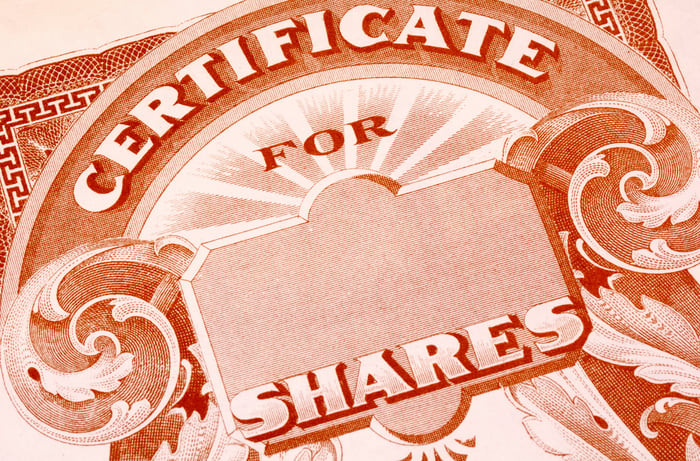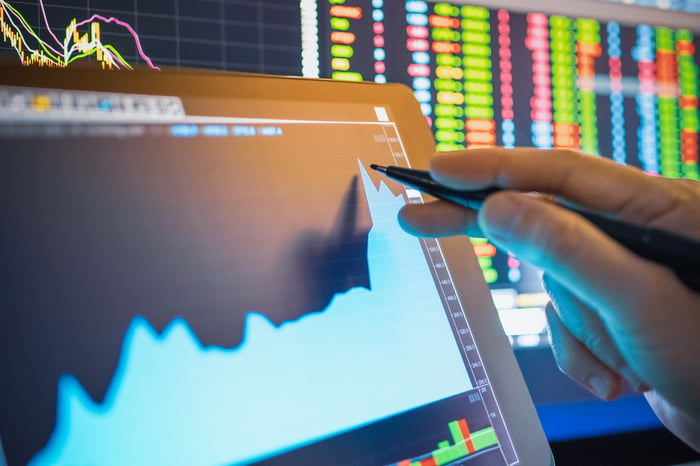For decades, retail investors have looked to Wall Street's brightest and most successful investors for inspiration -- and occasionally a free ride. Thanks to quarterly filed Form 13Fs with the Securities and Exchange Commission, which provide a snapshot of what top-tier money managers have been buying, selling, and holding, everyday investors have the opportunity to ride the coattails of investing greats like Warren Buffett, Bill Ackman, and Carl Icahn, just to name a few.
But it's not just billionaire asset managers who have been outperforming Wall Street on a fairly consistent basis. Dozens of elected officials on Capitol Hill have been cleaning up, as well.

Image source: Getty Images.
Congress is cleaning up on Wall Street
Collectively, lawmakers in Washington, D.C., have outperformed the benchmark S&P 500 (^GSPC 0.32%) in each of the past three years. According to a report published at the beginning of the year by Unusual Whales ("2023 Congressional Trading Report"), members of Congress may have made up to $1 billion in aggregate stock and options trades last year, which was up from $788 million in estimated trades in 2022.
Regardless of party affiliation, most members of Congress cleaned up. Republicans on Capitol Hill averaged an 18% return last year, while elected Democrats closed out the year with an average gain of more than 31%.
As you might imagine, technology stocks were behind some of the most robust gains for lawmakers in 2023. Rep. Brian Higgins' (D-NY) portfolio is believed to have more than tripled in value, largely thanks to a stake in the infrastructure backbone of the artificial intelligence (AI) revolution, Nvidia.
However, it's former Speaker of the House Nancy Pelosi (D-CA), along with her husband, who've truly dazzled Wall Street. For example, on Dec. 21, 2023, Pelosi filed a periodic transaction report that noted her venture capitalist husband purchased 50 call options for Nvidia on Nov. 22, 2023. These calls have a $120 strike price, with an expiration date of Dec. 20, 2024. Using historic trade data, I was able to locate a purchase price of $377.35 per contract. Today, these same contracts go for $765, equating to an unrealized gain of almost $1.94 million.
Pelosi's timing, along with that of a handful of other lawmakers, has been almost too good to be true.
🚨BREAKING🚨
-- unusual_whales (@unusual_whales) January 2, 2024
I have just released the full report on politicians trading in 2023.
Like every year since 2020, US politicians beat the market.
And many in Congress made unusually timed trades resulting in huge gains.
Here are the top performers of 2023. pic.twitter.com/ykf9VICsBw
An unlikely alliance in the Senate calls for an end to individual stock trading for lawmakers
When elected officials head to D.C., their constituents expect them to work on legislation that'll better the American people. But the growing net worth of select lawmakers, such as Nancy Pelosi, suggests some may be using their positions to fatten their pocketbooks.
In 2012, the Stop Trading on Congressional Knowledge Act ("STOCK Act") became law. It prohibits members of Congress and their immediate family members from using non-public information (like insider information) to privately profit from investments. It also requires members of Congress and their immediate families to report their trades above $1,000 no later than 45 days after they're completed.
With quite a few elected officials sitting on committees whose legislation can affect the individual stocks lawmakers and their immediate family members hold in their personal portfolios, you can get a feel for how this could be a problem.
While the STOCK Act does draw a clear line that prohibits trading on insider information, it can be incredibly difficult to prove that lawmakers on committees are investing with or without non-public information. Thus enter Senators Kirsten Gillibrand (D-NY) and Josh Hawley (R-MO).
You can probably count on one hand how many issues Gillibrand and Hawley see eye-to-eye on. However, one matter of importance they stand together on is the prospect of banning individual stock trading for members of Congress, the president, the vice president, the president's cabinet, and all spouses and children of these elected officials.
In July 2023, this unlikely duo introduced the "Ban Stock Trading for Government Officials Act." In addition to halting individual stock investment to remove any perceived conflicts of interest, the penalties for violating the rules would be steep. Executive branch officials would forfeit their profits and face a penalty totaling 10% of the value of their investment(s). It also increases the penalty for failing to report transactions, as required under the STOCK Act. Gillibrand notes that 1 in 7 members of the 117th Congress failed to report their trades properly under the STOCK Act.
What's more, the American public overwhelmingly supports banning members of Congress from trading individual stocks. A survey conducted by the University of Maryland on the same day Gillibrand and Hawley introduced their legislation found that 86% of respondents favored banning members of Congress from purchasing stock in individual companies.

Image source: Getty Images.
Lawmakers can still get rich without buying individual stocks -- and so can you!
Despite the American public strongly favoring legislation that would ban stock trades in individual companies for lawmakers on Capitol Hill, Gillibrand's and Hawley's bill hasn't advanced. But if future legislation does gain traction and our elected officials are banned from buying stakes in individual companies, you can rest assured that they (and you!) will still have a clear path to potential riches.
Professional and everyday investors spend countless hours each year reading financial reports and news releases to find the next great company that can outperform Wall Street's benchmark S&P 500. All the while, we often overlook or forget that the S&P 500 and its corresponding index funds have been surefire moneymakers for patient investors.
As its name implies, the S&P 500 is comprised of 500 of the largest publicly traded companies. It offers representation from virtually every sector and industry, thereby providing unrivaled diversification. It's also a solid indicator of the health of the U.S. economy.
What makes the S&P 500 and its tracking indexes so special is that they're able to take advantage of disproportionate periods of growth in the U.S. economy. Since the end of World War II in September 1945, the U.S. economy has worked its way through a dozen downturns. Nine of these economic drawdowns were over in less than a year, while none of the remaining three surpassed 18 months.
In comparison, almost every economic expansion has stuck around for multiple years, with two periods of growth topping the 10-year mark. As top-tier businesses grow in lockstep with the U.S. economy, Wall Street's benchmark indexes benefit.
But you don't have to take my word for it. The analysts at Crestmont Research have released an extensive data set that examines the rolling 20-year total returns, including dividends paid, of the S&P 500 dating back to 1900. Even though the S&P 500 didn't officially come into existence until 1923, researchers were able to locate its components in other major indexes in the 23 years prior to its creation. As a whole, this yielded 105 rolling 20-year periods of total return data (1919-2023).
Here's the jaw-dropper: All 105 rolling 20-year timelines generated a positive total return. In plain English, if you were to have, hypothetically, purchased an S&P 500 tracking index at any point since 1900 and held that position for 20 years, you'd have made money every single time.
Furthermore, the average annualized total return spanning these 105 years is close to 10%. This means the typical investor would be doubling their money every seven years or so.
If lawmakers and long-term-minded investors want to grow their wealth, the Vanguard S&P 500 ETF (VOO 0.35%) and SPDR S&P 500 ETF Trust (SPY 0.35%) have a lengthy history of doing just that. While both index funds attempt to mirror the performance of the S&P 500, the Vanguard S&P 500 ETF has the lower net expense ratio of the two (0.03% versus 0.09% for the SPDR S&P 500 ETF Trust). Over the course of a decade or two, six hundredths of a percent on an annual basis can add up.




